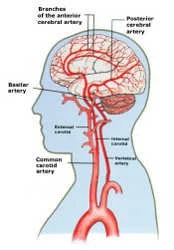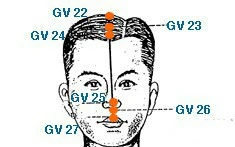Stroke Rehabilitation with Acupuncture, Tuina, and Tong Ren Therapy
Stroke is the leading cause of long-term disability in the US and the third leading cause of death. Every year strokes effect 15 million people worldwide with 5 million of those resulting in death. Of the remaining 10 million survivors at least 5 million of those will be disabled to varying degrees requiring immediate and long-term care to regain function, speech, memory, and other related impairments. Smoking, obesity, diabetes, atrial fibrillation, and high blood pressure are important risk factors for stroke, with high blood pressure being the most strongly correlated.
High blood pressure, diabetes, and other risk factors for stroke are commonly treated with Chinese Medicine and other complementary therapies. For stroke treatment, acupuncture serves both a preventative and a rehabilitative role. For prevention, Chinese Medicine works to offset the systemic imbalances that contribute to stroke. These are issues such as long-term emotional and physical strain, overwork, poor diet and dietary habits such as eating too fast, at odd hours, etc. and an overall lack of relaxation. In Chinese Medicine terms these habits weaken the spleen, kidney, and liver systems over a period of time and contribute to the chances of having a stroke and/or developing other health issues.
On the rehabilitative side, acupuncture works along with other western therapies such as physical therapy and other rehabilitation specialists to help regain function. Generally treatment involves resolving the underlying causes, using points overall for the specific type of stroke in Chinese Medicine terms, and then points for local issues. These "local" issues may include paralysis or loss of control in various limbs, facial paralysis, speech problems, and more. Proper treatment, then, involves points and techniques for both systemic and local issues. Traditional Chinese Medicine (TCM) theory divides stroke into two main types: flaccid (stemming from an overall deficiency) and tense (from an overall excess). Examples of symptom differences for these TCM diagnoses for stroke are as follows:
Traditional Chinese Medicine (TCM) theory divides stroke into two main types: flaccid (stemming from an overall deficiency) and tense (from an overall excess). Examples of symptom differences for these TCM diagnoses for stroke are as follows:
Flaccid type - sudden unconsciousness with flaccid signs such as closed eyes, open mouth, loss of bowel and/or urinary functions, cold limbs.
Tense type - sudden unconsciousness with tense signs such as clenching of the hands and/or mouth, redness of the head and/or face, no loss of bowel or urinary functions.
Treatment for each type will vary, and is described within our Traditional Chinese Medicine (TCM) acupuncture for stroke section. Generally points which aid for stroke are used, then points to clear excess or to tonify deficiencies, and then overall for resulting symptoms such as the use of CV 23 for speech issues (aphasia), ST 4, ST 6, ST 7, and/or UB 2 for facial paralysis, etc. See our section on stroke treatment for more point examples.
Viewpoints outside of TCM Treatments for Stroke:
Outside of TCM acupuncture there are other systems for stroke treatment and rehabilitation. One of these systems is Yamamoto New Scalp Acupuncture (YNSA). Yamamoto is useful for stroke rehabilitaion and a variety neurological and musculo-skeletal disorders. There have been a number of studies performed with YNSA and the results are very promising. A general introduction to the system can be found on our YNSA section.
Another system for stroke treatment, and our primary system, is the Tom Tam Healing System. The Tam Healing System combines acupuncture, tuina (deep tissue massage), and tong ren therapy (a form of medical qi gong) to aid in the rehabilitation of stroke. For stroke rehabilitation, a combination of techniques in our opinion is preferable to acupuncture alone. Acupuncture needling has certain effects on neurological function, pain, and movement, tuina promotes greater circulation and removes impediments to nerve function in a quick fashion, and tong ren will promote nerve and blood circulation and overall relaxation. For all of these techniques the primary treatment points are focused on regardless which one you are using at the time. For acupuncture you would also use various TCM points as appropriate for the patients overall diagnosis and for tuina certain points will be highlighted particularly along the neck and spine as indicated below.
Tam Healing System Points for Stroke:
Treatments generally begin with Tong Ren Therapy, then deep tuina on appropriate points, followed by acupuncture, and finish with deep tuina again including general work on the neck and spine and specific problem areas.
Tiandong - used to effect the circulation within the vertebral artery. Useful for a range of neurological conditions including MS, alzheimer's, and stroke.
SI 16 and TH 16- window of the sky point, used to effect circulation in the vertebral and occipital arteries. Used with a range of brain issues related to circulation.
Huatuo of C1 - effects communication to and from the brain and promotes circulation in the GV 20 area.
GV 20 - useful for stroke and all motor cortex issues.
LV 3 - descend liver wind and promote smooth circulation of energy.
LI 4 - clear wind from the face and head.
SI 17 - window of the sky point, very useful for facial issues, paralysis, headaches, TMJ, as well as high blood pressure.
ST 36 - tonify overall energy and promote proper circulation.
* Important points for tuina: Tiandong, all sky window points, GV 20, huatuo of C1 and then generally in the neck and spine through to problem areas.
Between prevention and rehabilitation there are acupuncture points and herbal medicines which can be used at the time of stroke to prevent complications. For completeness sake, I will mention these briefly, but it is best to obtain western medical care promptly if at all possible as western medicine excels in the treatment of acute medical emergencies such as stroke.
Acupressure/Acupuncture for Acute Stroke - In an emergency situation acupressure or acupuncture may be used on the acupuncture point GV 26. GV 26 is located between the nose and the upper lip on the midline of the body and you can press it deeply with a fingernail or with your thumb. GV 26 is the command point (link) for fainting and collapse and is used to help people regain consciousness from a variety of causes.
- In an emergency situation acupressure or acupuncture may be used on the acupuncture point GV 26. GV 26 is located between the nose and the upper lip on the midline of the body and you can press it deeply with a fingernail or with your thumb. GV 26 is the command point (link) for fainting and collapse and is used to help people regain consciousness from a variety of causes.
Herbal Medicine for Stroke (Acute, Prevention and Rehabilitation)
- There are a variety of herbal formulas that are useful for stroke, many containing herbs from the "open the orifices" and "extinguish wind" categories. While it can be useful, herbal medicine must be used appropriately and should never be used, specifically in serious medical conditions such as stroke, without proper consultation from a professional practitioner. A few of the more commonly used formulas are listed below:
Zhi Bao Dan - expels phlegm-heat and wind, useful for fever, coma, stroke, and/or convulsions.
Qiang Li Tian Ma Du Zhong Pian - expels wind and improves circulation, useful for paralysis from stroke, high blood pressure, and to aid in prevention of stroke.
Xin Nao Xue Shuan Pian - promotes circulation and activates the collaterals, useful for stroke, headache, numbness of the extremities and/or fatigue.
For more information related to the treatment of stroke, our website has a complete section for the treatment of stroke with Chinese Medicine. As the human and medical costs of stroke are very high, acupuncturists have an increasingly important role to play in the field of prevention and stroke rehabilitation. Proper use of these techniques can reduce disability in patients and lessen the overall strain on our medical system. As practitioners we should continue promoting health prevention through acupuncture and associated techniques as well as to further educate the public on the uses of acupuncture for stroke rehabilitation.
tag @yinyanghouse for questions/comments
Comment by Archived User
شكرا جزيلا ايه المحترف في الطب الصيني ، شكراً على كل هذه المعلومات
Comment by Chad Dupuis
You are very welcome, glad you are finding the information helpful for your family.
اهلا وسهلا بك ، سعيد لأنك وجدت المقالة مفيدة
- CV23 - Ridge Spring
- GV20 - Hundred Convergences
- GV26 - Water Trough
- LI4 - Union Valley
- LV3 - Great Surge
- SI16 - Celestial Windows
- SI17 - Celestial Countenance
- ST36 - Leg Three Li
- ST4 - Earth Granary
- ST6 - Jawbone
- ST7 - Below the Joint
- TH16 - Celestial Window
- UB2 - Bamboo Gathering
- X-TIANDONG - Sky Movement